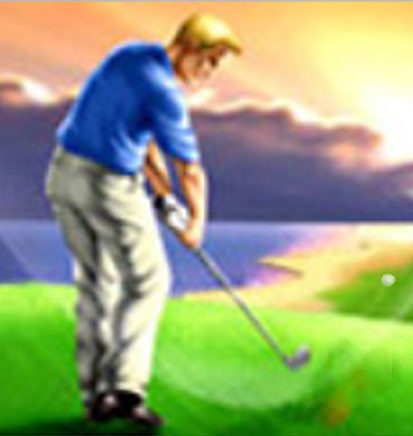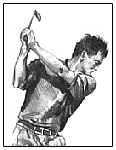
In this Special Report, I address a commonly misunderstood feature of the golf swing.
I regularly receive questions from around the world regarding different aspects of the swing and I am happy to oblige whenever I am able. The internet is a wonderful tool in that regard.
One of the most prevalent queries involves a correct golf backswing and is typically asked something to the effect:
“How long should my backswing be …. to parallel or past parallel?”
This is a great question… let’s get to it:
There is a persistent adage in golf that the club shaft should reach a position where it is parallel to the ground at the top of the backswing for a “full or complete backswing”. The logic continues that without achieving that position, you will be incapable of hitting the ball for distance or with maximum power.
In this report I will shatter that myth and show you why the quest for that position at the top is not necessary in today’s game (and why it could be hurting you and your scores).
First, let’s address the origin of the myth. During golf’s early evolution right on up to the 1930’s, golf club technology was is its infancy, at least relative to today’s advancements.
If you have ever seen those old black and white films of Bobby Jones and his long and graceful swing, you have no doubt witnessed his golf club dipping way past parallel during the backswing. In some sequences, it looks as though the shaft might actually smack him on his “hind quarters”!
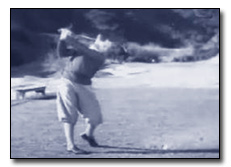
He hasn’t even finished his backswing yet!
In those days the only shafts available were made of wood, particularly hickory. Because of the inherent flex of the material, a longer swing was necessary in order to give the club head a longer travel distance in order to build up enough speed to deliver a solid blow.
Hence, the shafts were whippier than the steel and composite shafts of today and therefore the swing necessary to maximize their performance reflected that difference.
Steel shafts were approved by the R&A and USGA for use in competition in 1929. With the introduction of steel shafts and later the space age club head alloys, suddenly there was a new way to get the job done.
In essence, just think of the club shaft as the engine of the club:
Better, Stronger Engines = Faster, Longer Rides!
The transfer of momentum from club head to ball was now so much more efficient that the past parallel backswing started to be replaced with a parallel condition for most pros.
An added bonus was that this was also a position of more golf club control. This translated directly into more precise ball striking.
To illustrate this point, Ben Hogan’s early golf swing was very inconsistent and he would allow the club to dip dramatically past parallel at the top of the backswing. He fought an awful hook for many years until he “retooled” his swing after 1948.
The result was the more compact, precise swing (just to parallel with the driver) that enabled him to become arguably the greatest ball striker in the history of the game. Again, his swing allowed him to maximize the club (and ball) technology of the day.
Today’s golf equipment has progressed yet another degree since Hogan’s era. We now have more responsive “tuned” golf club shafts, perimeter weighted irons, low back weighted drivers, and incredibly advanced golf balls. One wonders where Hogan would rank with today’s stars if he were around to tee it up with these new, advanced tools of the trade.
Importantly, today’s players are taking full advantage of the equipment, and their swings again reflect the nature of the new technology.
The most overwhelming feature I see is shorter, more compact golf swings in today’s stars.
More specifically:
The length of the backswing is shortening, yet distance numbers continue to advance.
Do you know J.B. Holmes? This 26 year old prodigy won the FBR Open in Scottsdale, AZ last year (and in 2006), crushing the ball for 4 days with enormous drives and precise irons. He is also the 2nd longest driver on Tour this year with an average drive over 311 yards!
He accomplishes this with a backswing that is well short of parallel.
Brett Wetterich is also in the top 5 in driving distance and a past winner at the Byron Nelson. His swing is also short of parallel at the top.
In addition, 22 year old Anthony Kim (at ~5’9″) routinely smashes the ball over 300 yards and ranks 9th in driving distance. His “short”, compact swing defies logic. He had 2 wins last year, a spectacular Ryder Cup, Â and is being compared to a “young” Tiger Woods.
How do they do it? These players have combined powerful, compact golf swings with today’s golf equipment technology and achieved world class results. Here is a visual representation of what I am talking about:
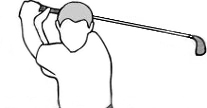 No
No
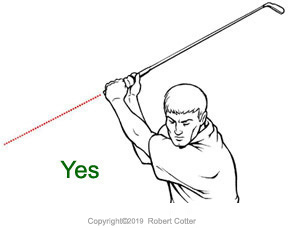
Now at this point you may be wondering:
“Well, how do I get the same power from a short swing?”
First, we are not talking about a short swing, but rather a more compact swing. Look at all the distance that heavy club head still has to travel to get back to the ball in the second picture… its a long way. There is still plenty of time to generate club head speed.
But more importantly: Your ultimate goal is Ball Speed.
That’s achieved from transferring all that club head mass powerfully into the back of the ball at impact. Club head speed is only part of the equation for ball speed.
Remember, you can have all the club head speed in the world as a result of a “huge” backswing, but miss the ball and have no ball speed. Or more commonly, hit the ball with a glancing blow (slice, hook, etc..). What a waste of effort, not to mention the strain on your back.
This back swing position is also great for people with backswing restriction due to physical limitations or age.
Here is a simple exercise you can try, if you are able, to help illustrate this point:
1) Put your arms down at your side and then slowly raise them upwards and outwards like a large bird.
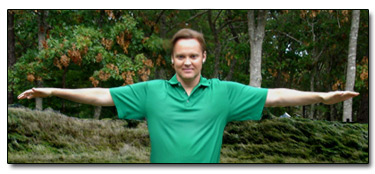
2) As you approach shoulder height, you will feel impingement in the shoulder area.
You see, the arms are designed to do most of their work below the shoulder level. Excessive lifting above the shoulder plane stresses the shoulder and can cause injury. Baseball pitchers commonly suffer rotator cuff injuries, as do golfers.
When the golfer learns to stop over rotating the shoulders and over extending the arms in the backswing, he or she has taken the first step to a more compact, powerful backswing.
Critical – “Is it as simple as taking a more compact backswing?”
Not quite, and if I could explain this to you right know I would, but this is something you need to see for yourself.
It is Visual.
You see there are 3 simple but critical elements to the backswing position in the second picture.
Without them you have an inefficient swing.
But get them right and all systems are on go for a simple yet powerful return to the back of that ball at impact… and an explosion at impact!
I go into detail in the The Key To A Repeating Golf Swing exactly what these elements are and how to achieve them, and then I show you how to quickly train your body to reproduce them so the downswing swing becomes virtually automatic:
And when the backswing with these 3 three critical elements is combined with the actual Key (the Key is related to an entirely different part of the body) that is the foundation of my teaching, golfers can transform their games literally overnight.
And the experience is the same for Men, Women, and Junior golfers, whether they are picking up a club for the first time after 40, or trying to shave off those last few strokes to break 70.

And here’s my personal Guarantee to you for trying my system…
 I personally guarantee that if you make a sincere effort to apply the principles in “The Key To A Repeating Golf Swing” within the next 45 days, you’ll realize lower scores and more enjoyment from your game. But if you aren’t 100% satisfied, email me your refund request and electronic payment receipt within 45 days of purchase and you’ll be issued a prompt, no-hassle refund. Hard Copy product must be returned in original condition for full product refund (minus shipping).
I personally guarantee that if you make a sincere effort to apply the principles in “The Key To A Repeating Golf Swing” within the next 45 days, you’ll realize lower scores and more enjoyment from your game. But if you aren’t 100% satisfied, email me your refund request and electronic payment receipt within 45 days of purchase and you’ll be issued a prompt, no-hassle refund. Hard Copy product must be returned in original condition for full product refund (minus shipping).
So you’ve got nothing to lose except strokes off your game.
$74 Holiday Package Special Discount

Save 50%, Very Limited Time
(Sale in Progress Now)
only $37.00
About the Author: Robert Cotter is a Patent Award winning golf ball design engineer and fine player. His interaction with the top players in the game led to his discovery of The Key to a pro caliber golf swing. He is the author of “The Key To A Repeating Golf Swing” which has taught over 5000 golfers in 60+ countries and has a success rate of >96%.
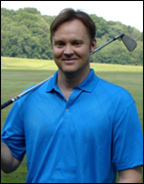
Make this year your year in golf – Discover The Key today.
